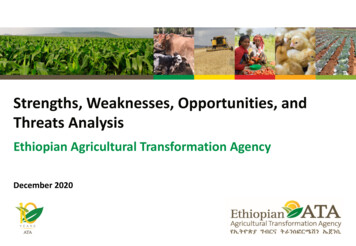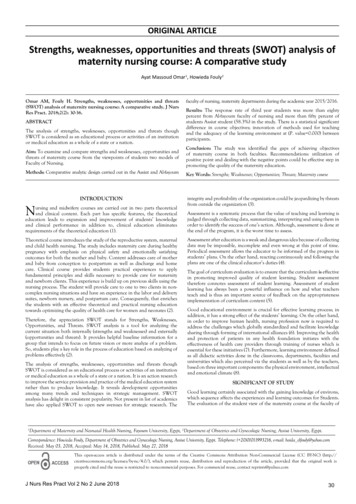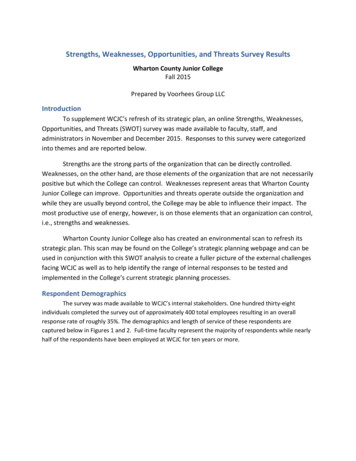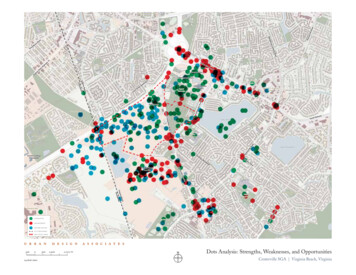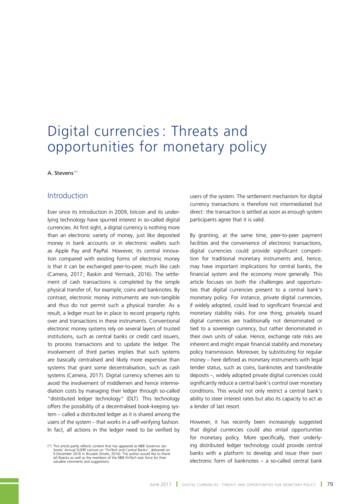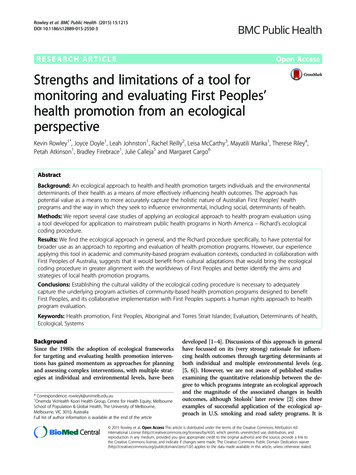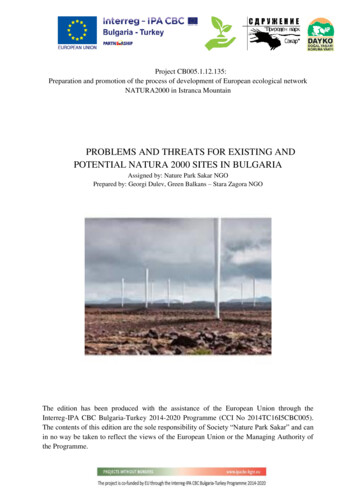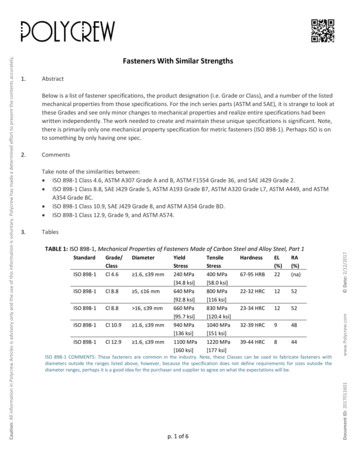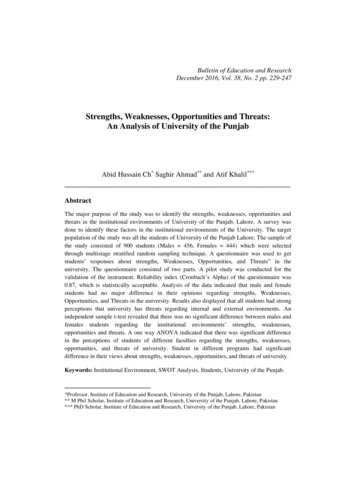
Transcription
Bulletin of Education and ResearchDecember 2016, Vol. 38, No. 2 pp. 229-247Strengths, Weaknesses, Opportunities and Threats:An Analysis of University of the PunjabAbid Hussain Ch* Saghir Ahmad** and Atif Khalil***AbstractThe major purpose of the study was to identify the strengths, weaknesses, opportunities andthreats in the institutional environments of University of the Punjab, Lahore. A survey wasdone to identify these factors in the institutional environments of the University. The targetpopulation of the study was all the students of University of the Punjab Lahore. The sample ofthe study consisted of 900 students (Males 456, Females 444) which were selectedthrough multistage stratified random sampling technique. A questionnaire was used to getstudents’ responses about strengths, Weaknesses, Opportunities, and Threats” in theuniversity. The questionnaire consisted of two parts. A pilot study was conducted for thevalidation of the instrument. Reliability index (Cronbach’s Alpha) of the questionnaire was0.87, which is statistically acceptable. Analysis of the data indicated that male and femalestudents had no major difference in their opinions regarding strengths, Weaknesses,Opportunities, and Threats in the university. Results also displayed that all students had strongperceptions that university has threats regarding internal and external environments. Anindependent sample t-test revealed that there was no significant difference between males andfemales students regarding the institutional environments’ strengths, weaknesses,opportunities and threats. A one way ANOVA indicated that there was significant differencein the perceptions of students of different faculties regarding the strengths, weaknesses,opportunities, and threats of university. Student in different programs had significantdifference in their views about strengths, weaknesses, opportunities, and threats of university.Keywords: Institutional Environment, SWOT Analysis, Students, University of the Punjab.*Professor, Institute of Education and Research, University of the Punjab, Lahore, Pakistan** M Phil Scholar, Institute of Education and Research, University of the Punjab, Lahore, Pakistan*** PhD Scholar, Institute of Education and Research, University of the Punjab, Lahore, Pakistan
Strengths, Weaknesses, Opportunities and Threats Analysis of PU230IntroductionStrategic planning is future facing and is based on the analysis of foreseen orpredicted trends and scenarios, it is flexible and oriented towards making a reality ofvision (Kotler & Murphy, 1981; Lerner, 1999; Pisel, 2001, 2008; Paris, 2003;Oztermel, Kubat, &Taskin, 2009; Hinton, 2012).The primary functions of strategicadministration are to comprehend the situation through SWOT exploration,characterize institutional objectives, distinguish alternatives, settle on and executeplans and assess real execution. Thus, strategic planning intentions to manipulate theinnovative and distinctive trends of future after analyzing the institutions internallyand externally rather than long range planning, which attempts to enhance fortomorrow the designs of today (Drucker, 1980).Today's schools, colleges and universities have encountered with fast change.Educational managers are provoking with changes connected with current facilities,progressing innovation, evolving demographics, expanding contention, increasingcosts and finance etc. The field of education has started to perceive that ecologicalanalysis in strategic planning is compulsory in demand to retain with a specificresponsiveness to the quick dynamic environment (Agwu, 1992; Busler, 1992;Williams, 1992; Hall, 1994).Pakistan is also a developing country and we cannot compete with developedcountries in higher education field. The main causes of this situation are lack ofresources, implementation of plans and incompetent politicians. Policies are madewithout strategic planning process. The big problem is that we don’t see the presentsituations of education sector, needs of the environment and many other things duringpolicy preparation. Therefore, to enhance the quality of universities and to competewith the progressive countries, we shall have to make plans after evaluating thecurrent needs. The higher educational institutions need to endeavor current assets andfind new opportunities to compete with the progressive nations. Governmentalsubsidy is diminishing which has undermined the governmental institutes’development. Institutes have not capacity to afford the daily expenditures.Higher education needs to compete the progressions and defies that are goingon due to which strategic planning should be there but for this the analysis ofenvironment of educational institutions as the decisive stride in the strategic planningis like business sector (Tsiakkiros & Pashiardis, 2002).
Abid, Saghir & Atif231Strategic planning has developed to meet the demands of the public andprivate sectors to achieve the desired goals. Strategic planning procedure is a point ofconvergence for the effective administration of higher education organizations.Administration assesses a foundation's qualities, shortcomings, objectives, assetprerequisites and future forecasts in strategic planning, due to which institutionscannot ignore the SWOT analysis to make a future plan. It provides the help andframework to the administrators who have to take right decisions for the bettermentof higher education. The logic behind the SWOT investigation is that the system of anassociation embraces ought to coordinate the ecological dangers and opportunitieswith the association's shortcomings and particularly its qualities. It attempts to set upa key fit between an association's interior qualities and shortcomings and theopportunities and dangers postured by its outer surroundings. This rationale hasgenerally been acknowledged as a dominant standard of current administration (Beer,Voelpel, Leibold, & Tekie, 2005).SWOT inspection has its starting points in the 1960s. The asset constructview centers in light of the interior assets, capacities and center capabilities of theassociation and advocates building policies on these establishments to guarantee theintensity of the association and the allurement of the modern business division(Learned et al., 1965).SWOT rests for Strength, Weakness, Opportunity, and Threat. A SWOTinvestigation guides you to recognize your association's qualities and shortcomings(S-W) and additionally more extensive opportunities and threats (O-T). Adding to amore full consciousness of the circumstance assists with both strategic planning andchoice making. The SWOT technique was initially created for business and industryhowever it is too helpful in the work of group wellbeing and improvement ofeducation and even for self-awareness (University of Kansas, 2014).SWOT concentrates on inward and outside components. Interior elementsmight include: Personnel, money, capacity building and board execution and so on.Outside elements might include: Economic atmosphere, mechanical changes,enactment, social society changes, contenders and so forth.
Strengths, Weaknesses, Opportunities and Threats Analysis of PU232As per Liao (2013) parts of SWOT investigation are:1. Strength (S) is examination of quality, circumstance or condition which thequality of an association or organization reveals. The important to be done inthis investigation is, each organization or association need to evaluate thequalities and shortcomings in contrast with its rivals. For instance, if thequality of organization is unbeatable in their innovation, the point ofpreference can be adventure to fill a business sector fragment that requires alevel of innovation.2. A weakness (W) is investigation of shortcoming, circumstance or conditionof an association or organization. It is an approach to break down theshortcomings in an organization or association that was a genuine deterrent inthe advancement of an organization or association.3. Opportunity (O) is investigation of chance, circumstance or condition which anopen door at the outside of an association or organization and gives the chanceof development to the association later on. It is to search for circumstances orleap forward that permit an organization or association to go ahead.4. Threat (T) is investigation of threat, how to break down the test or danger thatmust be confronted by an organization or association to face assortment ofnatural variable that didn't good to an organization or association which come tobe reason for crumbling. In the event that did not soon be succeeded, the riskwould be an obstruction for a business concerned at present and what is to come.Delahaye (2000) depicted that analysis of SWOT is not another thought inthe business rehearse. This model began from the Harvard Business School and hasoverwhelmed strategic arrangements since the 1950s (Lerner, 1999). Numerousindividuals regularly misperceive SWOT as synonymous with key arranging. Truthbe told, a SWOT examination is one and only of numerous instruments that can beutilized as a part of an association's strategic arranging process for environmentalscrutiny. There are various strategies for ecological analysis.The outcomes of the SWOT investigation make the system for picking atechnique arranged towards matching the requirements of environment whileconsidering the current interior potential, the SWOT analysis alludes mapping andrecognizing as the main thrusts which the institution needs to consider and once thesefactors have been distinguished, applicable techniques can be created to address thesepowers (Christensen, 1997).
Abid, Saghir & Atif233For a successful analysis, a focal point or reason for existing is vital. Whileexamining inner environment, the inquiry is not worried about past victories ordisappointments. The analysis should be future oriented (Kheng-Hor & Munro-Smith,1999). According to them, there are two vital parts for inside environmentalinvestigation. Firstly, association administrators require a precise evaluation of theassociation's capacity before they can create objectives and methodologies. It islikewise vital to note that the institutional objectives or goals are trying as well asSMART which implies that the objectives must be particular, quantifiable, achievable,important and timed. Secondly, the analysis of inner environment should support toprepare a draft of activity. That is to create plans that propose to expand theassociation's strengths and minimize weaknesses. These two purposes of inwardanalysis of environment support to have an obvious image of an association's presentcircumstance with both strengths and weaknesses. Important data for an association'sinside analysis might incorporate fund, character, staff liability or inspiration, aptitudes,association frameworks and structures (Horn & Niemann, 1994). There is a verysuitable framework that is called '7S system' for inside situations, which incorporatestructure, system, style, staff, skills, strategy and the shared values (Porter, 1985).The scanning of the environment is an endeavor to distinguish changes thatinfluence the organization. In this time of globalization, universities have encounteredquick changes, for example, evolving innovation, expanding rivalry, increasing costs,financing cuts and maturing resources (Kriemadis, 1997). The survival of everyeducational institute depends on its ability for strategic planning and executing toadjust to variations. Many institutes do not have the ability to react to the turbulentcircumstances adequately and productively (Navarro & Gallardo, 2003).SWOT is a broadly utilized instrument for examining interior and outsidesituations in order to achieve a methodical comprehension of a strategic administrationcircumstance (Kolter, 1988; Wheelen & Hunger, 1995). Thus, it urges strategists toreceive a procedure that can best adapt to the circumstance. Its belief can even befollowed back to Sun Tzu's, The Art of War, "Recognize your foe, and see yourself,you can battle a hundred fights with any threat of annihilation" (Tzu, BC 600).This study will help the higher education sector, in targeting the issuesregarding the institutional environments in public sectors. This study will provideknowledge of strengths, weaknesses, opportunities and threats regarding highereducation. The study will help to promote the SWOT analysis in education sectorsand it is expected that the results of the study would be useful for higher educationsystem in decision making and need based planning.
Strengths, Weaknesses, Opportunities and Threats Analysis of PU234Objectives of the StudyThe objectives of the study were to:1. examine the institutional environment of University of the Punjab internallyand externally.2. identify the strengths of University of the Punjab.3. identify the weaknesses of University of the Punjab.4. identify the opportunities in University of the Punjab.5. identify the threats of University of the Punjab.Research MethodologyQuantitative approach was employed for conducting the study. The study wasdescriptive and survey type in nature. The target population of the study wasconsisted of students from University of the Punjab of Pakistan located in Lahore.The study was conducted on university students by using multi-stage stratifiedrandom sampling technique. At the first stage, 13 faculties were selected by usingstratified sampling technique from University of the Punjab. At the second stage,three departments randomly selected from each faculty. At the third stage, 75 studentswere taken randomly as a sample from each faculty.
Abid, Saghir & Atif235List of faculties1.Art &Humanities2.Behavioral andSocial Sciences3.Commerce4.Economics andManagementSciences5.Education6.Engineering &Technology7.Islamic Studies8.LawS. departmentsThreeDepartmentsselectedfrom eachFacultyThreeDepartments selectedfrom eachFaculty1.Department of Asian Studies2.Department of Archaeolo
choice making. The SWOT technique was initially created for business and industry however it is too helpful in the work of group wellbeing and improvement of education and even for self-awareness (University of Kansas, 2014). SWOT concentrates on inward and outside components. Interior elementsFile Size: 463KBPage Count: 19
